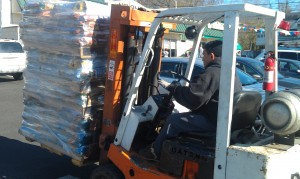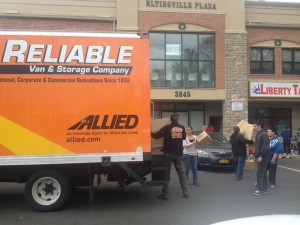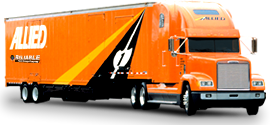
1. Always wear gloves, even if you are not feeling cold. Gloves will keep your hands warm, and protect them from cuts and scratches.
2. Protect your ears. Wear a hat or ear muffs to keep your ears from getting frostbite.
3. Make sure you wear boots with proper traction. If it’s slushy outside, line them with plastic bags. This will create extra insulation against the wetness on your skin.
4. If you’re moving from a warmer climate to a colder climate, pack a bag of necessities and keep it close by. The bag should contain items like gloves, hats, boots, and a warm coat. This way you can easily gear up when you arrive to your new destination.
5. Check the rental truck before you leave the lot to ensure that the heater is in proper working order. If the heat is broken, you will not only be uncomfortable, but you’ll have no way to remove the frost and fog from the windshield.
6. If the weather conditions are extreme and you plan to stay in the extreme cold overnight, make sure the moving truck has a block heater installed. A block heater warms an engine to increase the chances that the engine will start. It also warms up the vehicle faster than it normally would in extremely cold weather.
7. Keep the back area of the moving truck clear of snow and ice. If necessary, salt the area to prevent ice buildup and shovel where the moving truck is parked. It’s important to keep the work area down to the bare pavement, if possible.
8. Shovel the walkway where you and your helpers are traveling to and from the truck. This not only aids in everyone’s safety, but it speeds up the moving process by allowing everyone to walk faster than they would be able to if the walkway was snowy and slippery. In addition, if the area is kept clean from snow, the snow will not be transferred into the back of the moving truck, making the floor inside the truck dangerous to walk upon.
9. Designate one of your helpers to be a “spotter” when carrying heavy items in the snow. The spotter will guide the others to the moving truck, and can quickly step in if someone falls or if the box accidentally slips from the others’ hands.
10. Drink plenty of water. Even though it’s cold, the body is still working excessively and needs to be replenished. Also, be sure to take breaks indoors where you can warm up and regain your energy.
11. Keep an eye on the weather. It’s important to stay on top of any changes in the weather, so use the radio in your truck and listen for updates.
12. Drive cautiously. Moving trucks require a much greater stopping distance than cars. The heavier the truck, the greater the distance needed to stop. A passenger vehicle traveling at 55 mph can stop in about 130 to 140 feet. A large truck traveling at the same speed can take up to 400 feet to stop. Snowy conditions complicate this fact, so even more distance will be needed to break on time. Carry flares and reflector triangles in the truck, so that if the rental truck slides off the road, you can attract help.
13. Chances are that your moving truck is longer than your normal automobile, which poses a problem especially when parking near snow banks. Keep a shovel handy in case your truck gets stuck in a snow bank. A bag of salt will also be useful in case you need added traction to get the vehicle out of an icy spot.
14. You may want to ask the rental agency whether tire chains are required. In some areas and times of the year, chains are mandatory.
15. Remember that not everything will make it through a cold move. If something will freeze or break in the cold weather (such as wine) you should hire a third party to transport it. Be extra careful with your pets as they are more susceptible to freezing than you are. Pets are not allowed in the cargo area of moving trucks, so it may be wise to make special arrangements for them. A Reliable Van & Storage representative can make these arrangements for you.
16. Protect your plants. Even when in a heated rental truck, it is unlikely for your plants to survive the trip in such harsh conditions. If you plan to transport your plants, cover them in plastic to protect them from drafts that occur from opening and closing the doors of the vehicle. Make sure the bags have a slit at the top so your plants can breathe. Also, keep them accessible; bring them inside as soon as you arrive at your new residence. Even with these precautions, moving plants is always at the owner’s risk.
17. Call your new utility company at destination ahead of time so the heat will be on when you get there.
18. When unpacking your belongings after having been in the cold for some time, it is best to let your china, crystal, and any other glassware sit in the box until it comes up to room temperature. The cold makes the glass brittle.
19. Most electronics can handle the cold, but not extreme cold or condensation. Make sure that your electronic devices are well packed in moving blankets to insulate them. When you arrive at your new home, allow your electronics a full day to acclimate to your room temperature before plugging them in.
Winter moves are a challenge, but if you follow these tips you will be well-prepared for the job. The key is to take your time. Accidents happen quickly and without warning. Slow down, take precautions, and err on the safe side.
* It is also important to remember that all professional moving companies are less busy during the winter season. As a result, our agency offers impressive discounts during this time of year. With much lower rates, you will save money if you choose to move with Reliable during the cold season compared to any other time of year. So if you want to avoid the hassle, call Reliable Van & Storage and schedule your relocation with us. Our trained professionals have been moving household goods in snowy weather for over 86 years!
Subscribe to Reliable Van And Storage's Blog

















Comments